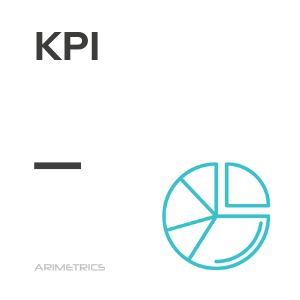
Definition:
KPIs, an acronym for Key Performance Indicator,are metrics used to quantify objectives that reflect the strategic performance of digital marketing campaigns. They are indicators directly linked to the objectives that are usually defined in percentage values.
Choosing the right KPIs or performance indicators is based on a good understanding of what is important to the organization and this often depends on the department that is measuring performance. For example, the KPIs useful for financing will be very different from the key performance indicators assigned to sales.
The SMART rule applies to them, since it is considered that they must be specific, measurable, achievable, relevant and temporary (a deadline must be limited for the achievement of the objective).
KPI Selection
Since there is a need to understand well what is important, the techniques for assessing the current state of the company and its key activities are associated with the selection of performance indicators. These evaluations often lead to the identification of potential improvements, so performance indicators are routinely associated with performance improvement initiatives.
KPIs represent a set of measures that focus on the aspects of the organization’s performance that are most critical to its current and future success. They are rarely new to the organization, meaning they have either not been recognized before or were gathering dust somewhere unknown to the current management team.
How to identify KPIs
Performance indicators differ from business objectives or goals. A school might consider its students’ failure rate as a key performance indicator that could help the school understand its position in the education community, while a company might consider the percentage of returning customer revenue as a potential KPI.
The key stages for identifying key performance indicators are:
- Have a predefined business process.
- Have requirements for such a process.
- Have a quantitative/qualitative measurement of results and comparison with set goals.
- Investigate variations and adjust processes or resources to achieve short-term goals.
Key performance indicators are ways to periodically evaluate the performance of organizations, business units and their divisions, departments and employees. Consequently, they are defined in a way that is understandable, meaningful, and measurable. They are rarely defined in such a way that their compliance is hindered by factors considered as uncontrollable by the organizations or persons responsible.
Differences between metrics and KPIs
A metric can become a KPI. However, for this to happen, the metric must be very relevant and greatly affect the business. This is only possible when the metric has the ability to provide recommendations for actions that can have a big impact on the company. For example, the average order value can be used as a KPI because it greatly affects, being able to increase the orders simply by increasing the size of the orders. Revenue per click, revenue per visit, revenue per acquisition, cost per acquisition, etc., are other examples of metrics that can be used as key performance indicators.
How to find a good KPI
A good KPI has to be measurable and available, impact the line of business, be relevant, useful instantly and timely. To achieve this, you have to follow the following steps:
- Before starting the search process, you must have a total knowledge of the business and the company you want to analyze.
- The company’s objectives must be translated into measurable goals. The objectives may be for example to increase sales by 5% in the next three months by increasing the average order value from X to 2X.
- Once those goals are selected, a KPI is chosen for each of the objectives.
Examples of KPIs
Enterprise KPIs
- Gross profit. It is the profit obtained after production and the cost of manufacturing. The formula to obtain it is “sales revenue – direct cost“. Direct cost is the cost of manufacturing a product.
- Revenue Growth Rate. It is the percentage increase in sales between two time periods. The formula would be: (Income of the current month – Income of the previous month) / (Income of the previous month) * 100.
Web Analytics KPI
- Return on Investment (ROI). It is used to evaluate the effectiveness of the investment or to compare the effectiveness of different investments. ROI = (Return on investment – Cost of investment) / Cost of investment.
- Cost per lead. It is the average cost of generating a lead. The formula is: Total cost / Total leads.
- Conversion rate. It is the percentage of visits that results in conversions of targets or transactions. The formula is: (Total Conversions / Total Visits) * 100.
KPI de SEO
- Conversions from organic traffic. Users who convert from search engine traffic
- Keyword ranking: Position of a certain keyword in a search engine
- CTR (Click Through Rate). Clicks / Impressions in search results (this metric is obtained, for example in webmaster tools)
SEM KPIs
- CPC. Cost per click.
- CPA. Cost per acquisition.
- Conversions from paid traffic. Users converting from paid traffic
